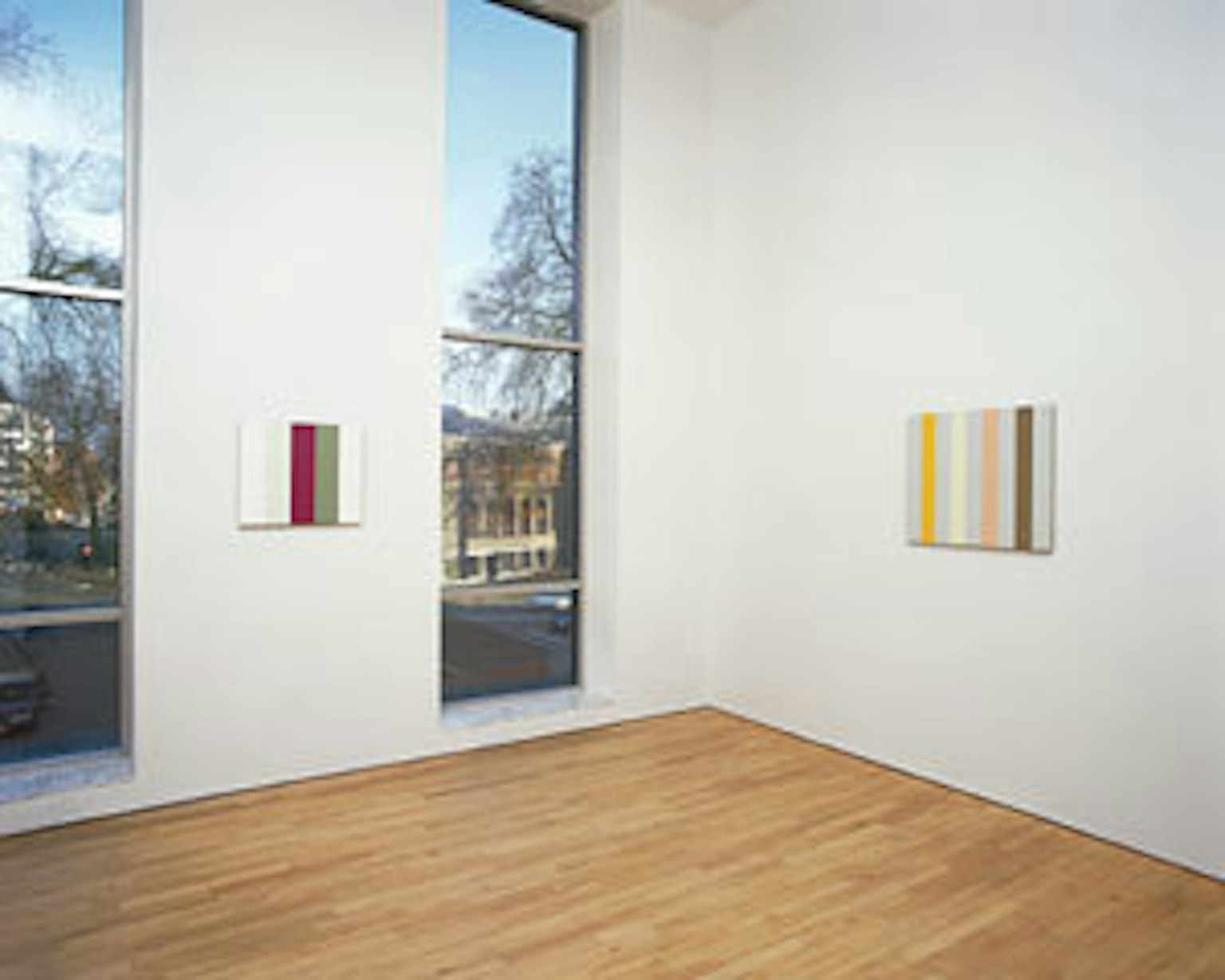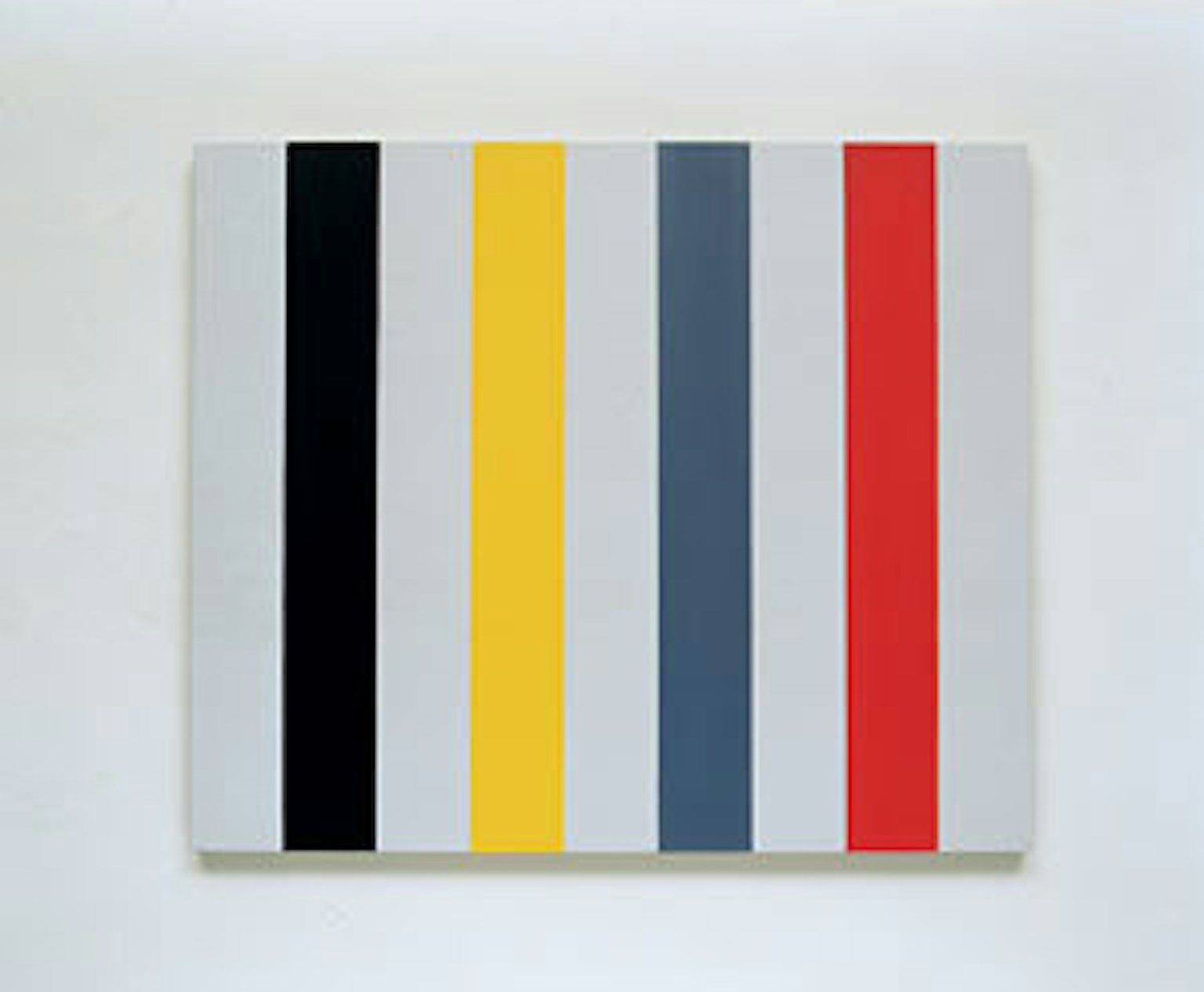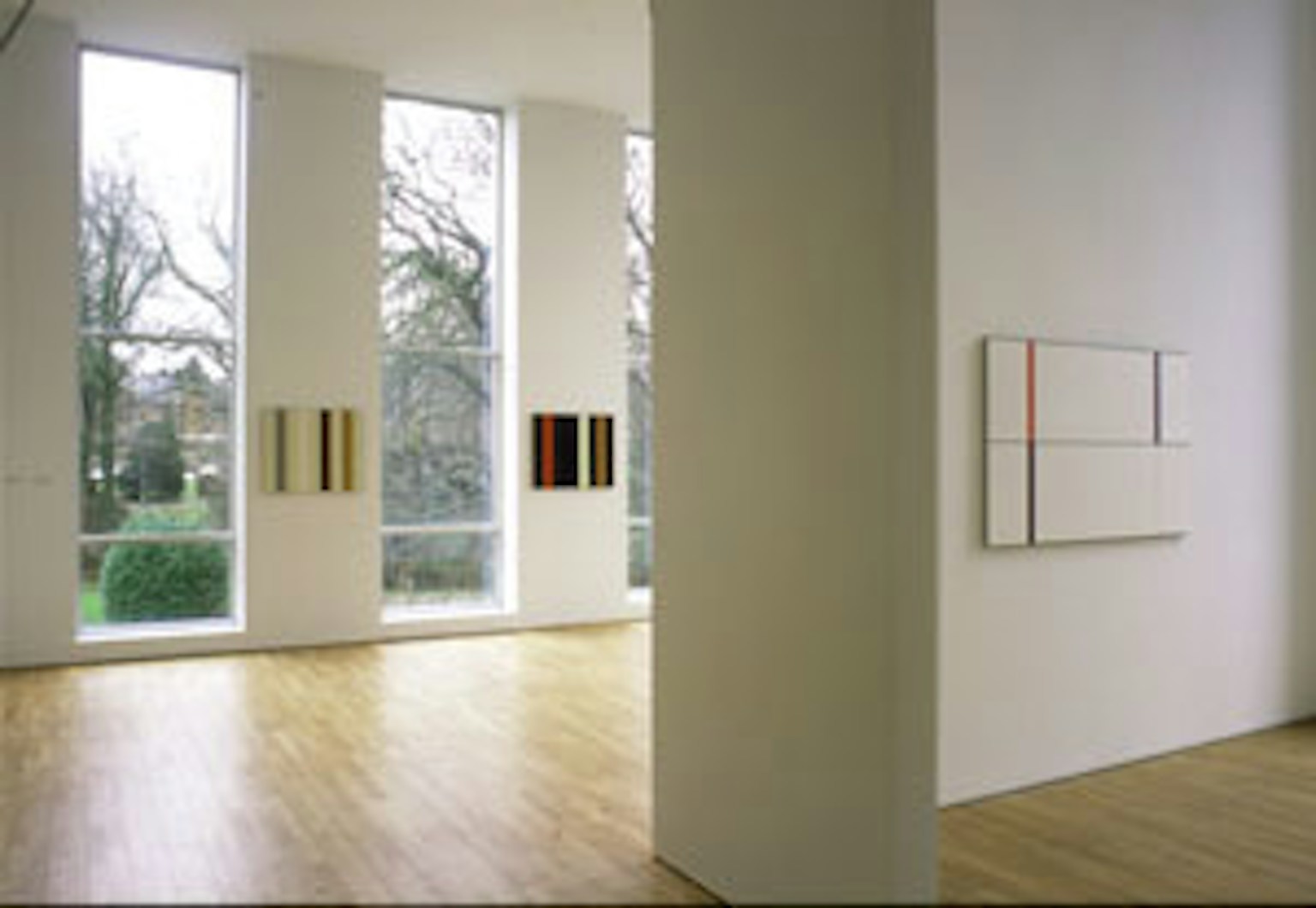Vertical Thoughts
6.Apr.02

At first sight Steven Aalders’s paintings look both deceptively simple and extremely sophisticated.
At first sight Steven Aalders’s paintings look both deceptively simple and extremely sophisticated. One by one they confront us with a balanced, even harmonious image, based on a carefully studied use of basic visual elements, such as lines, areas and shapes, colours and tones, rhythm and composition, layeredness and texture, paint and canvas. These paintings merely draw attention to themselves. They invite the public to concentrate only on their inherent qualities, to become wrapped up in this world of mere painterly means. However, almost instantly, upon first looking at them, the very same pictures evoke associations which interfere with this direct, instinctive engrossment, aspects which seem to distract from the works themselves, and yet, which at the same time seem to multiply their layeredness and make them even more interesting. Quite a few of the paintings emphatically and directly remind us of Piet Mondriaan. One is inclined to presume that this cannot possibly interfere with our engrossment, as precisely Mondriaan was one of the pioneers of this sort of ‘free’ painting. Mondriaan was one of the first who, after a gradual process of abstraction, finally severed all ties with the external world of objects and images, i.e. with the modern world that became ever more erratic, fragmentary, incomprehensible and ‘external’. This process should allow the public to interiorize, beyond that which is visible, a universal force field, enclosed in itself. The work of Steven Aalders, too, invites us to contemplate a purely pictorial world. However, by referring expressly to the Dutch pioneer of abstraction, by as it were paraphrasing him, Aalders also obstructs the process of pure contemplation.
Through the explicit reference Aalders burdens himself - and the public - with the millstone of the twentieth-century tradition of abstract art. Furthermore, precisely Mondriaan’s neoplastic idiolect has since served a variety of advertising purposes - it has been used to market shampoo and to decorate cyclists’ torsos. Quite contrary to his original purpose of opening up the inner world of emotions, Mondriaan now belongs to the culture of pop and visual images to no lesser extent than Warhol’s Brilloboxes or Marilyns. Because of this we cannot simply and directly, without referring to the external world, merge with Aalders’s harmonious and still pictorial world. What clearly emerges from this concise outline of Mondriaan’s art, is the fact that from the very start abstract painting literally could exist only through and within the contemplation and perception of the viewer. As the three-dimensional effect of the painting waned, the importance of the concrete space before the pictorial surface and of the interaction between the work, the public and the exhibition space increased. From this point of view Minimal Art did not constitute a rift with abstract painting, but rather a logical sequel to it. In e.g. Donald Judd’s work the material and constructive elements of the abstract work of art became autonomous ‘specific objects’. Through their materiality and scale these related directly to the concrete space that surrounded them, and to the physicality of the corporeality of the visitors that moved within this space. Apart from Mondriaan, also Minimal Art is present in Aalders’s art, albeit somewhat less articulate. This is obvious from the painting Going West, which is directly inspired by Aalders’s personal perception of Judd’s 100 Boxes, but above all from certain structural features that recur throughout the artist’s oeuvre. The images e.g. always show a modular structure: a grid, functioning as a support below the work, becomes visible in the identical rectangular shapes of the coloured bands, while it is overpainted in the white spaces in-between (if there are any, for that matter). It is also a striking fact that if there are black lines, these are always horizontal, never vertical. This feature makes the works fundamentally different from those of Mondriaan, as in the latter the interaction between horizontals and verticals sometimes causes grave tensions and frictions.
The work of Aalders is precisely devoid of all conflict and tension. Aalders views Mondriaan through minimalist glasses: repetition, reflection and symmetry steer and rhythm the perception of the work. While the recurring colour bands or the alternation of coloured stripes and white intervals cause the public to move the eyes to and fro across the work as if it were a wide-screen television set, the movement is in addition accompanied by the horizontal black lines, which behave rather static, as opposed to the constantly moving and jumping colour bands. This effect even brings about associations with the horizontal windows of modernist architecture. The calculated precision and extreme accuracy with which the paintings have been prepared, executed and finished, too, are reminiscent of Minimal Art. From Aalders words, quoted in Tegenbosch’s essay (in this volume) we can deduce that the artist has a predilection for the modernist critical detachedness and austerity Minimalism and its pursuit of ‘wholeness’ radiate. But, like Mondriaan, Judd too can no longer be the subject of a ‘pure’, critical, detached contemplation. The language of Minimalism has conquered the realm of architecture, has acquired a certain degree of ‘smoothness’ in the process, and as such, it has set the standard for e.g. up-market shoe and clothes shops. There is no denying the fact that also Steven Aalders’s works, viewed through eyes sensitive to the latest trends, radiate a certain decorative temptation. Thus, the paintings, which on the one hand isolate themselves from the exterior world and invite us to inner contemplation, are on the other hand in a subtle manner quite revealing about the outer world of objects and images, and about the way in which we perceive this world. From another point of view, it is precisely the ‘horizontal’ severing of the image we just described that may cause the impression that the vertical bands of colour continue endlessly upwards and downwards within the ‘space’ of the image. Unlike within the pure, concrete materiality of the object, postulated by Minimal Art, an illusionary space can reveal itself within Aalders’s paintings, which, like Mondriaan’s universe, extends infinitely. Apart from references to Mondriaan and Minimal Art, Aalders’s work contains other references that are often quoted expressly in the titles. Colour Studies is a series of paintings composed of alternating white and coloured bands, which refers to masterworks from the history of art; the old masters, from Bouts to Saenredam, are always mentioned in the title of the separate works.
Other series, like Megisti and Findhorn, refer to the perception of landscapes. Contrary to Mondriaan and Minimal Art, and to our first impression of his work, Aalders does not entirely sever the link with the concrete world outside. This fact can be deduced from e.g. the particular colour scheme of the individual works, which violates the neoplastic dogma that imposed the sole use of the primary colours red, yellow and blue. Aalders’s paintings are the result of a richly gradated and strongly purged perception. He shows us how his perception is affected by sensory experiences, momentary moods, as well as by scientific theories of colour, his knowledge of the history of art and personal choices. What he perceives is subsequently translated into a slow and meticulous pictorial process, in which calculated assessment and spontaneous emotions are intricately interwoven. The complexity of the process can be judged from the variegated textures and layers that characterize the pictorial surface of his paintings. The oils, the contemplative slowness of the process of painting and the sensitive microrelief of the pictorial surface bear witness to a handicraft that contrasts sharply with the minimalist goals of an impersonal and industrial production. With his paintings Steven Aalders severely tries himself and the public. The paintings raise fundamental questions, if not concerning the sense of the art painting, than certainly concerning the sense this abstract, apparently harmonious paintings can still convey three quarters of a century after the Mondriaan and nearly half a century after Minimal Art arose. However, anyone who takes the time to look carefully at the paintings, ignoring their austere logic of historical references, will discover why it is still sensible to paint in today’s world: because, now that the art of painting is free of the constraints of the logic of progress, every painting meets us with the radiant truth that its significance resides in its own individual power. The painting requires the public to look with sensitive, empathetic and extremely observant eyes. Steven Aalders’s oeuvre on the one hand is the result of a conscious extreme reduction of visual means, while on the other hand - and precisely because of this - it constitutes the point of departure of a visual perceptive process that vigourously resists all reduction. This refined complexity allows the artists to verge on the decorative, while at the same time leaving the decorative light-years behind.

















